A Project of the Hudson River Estuary Program
Compiled by Tom Lake, Consulting Naturalist
While enjoying outdoor spaces, please continue to follow the CDC/NYSDOH guidelines for preventing the spread of colds, flu, and COVID-19. To find out more about enjoying DEC lands and New York's State Parks, visit DEC's website #Recreate Local; https://www.dec.ny.gov/outdoor/119881.html
Try to keep at least six (6) feet of distance between you and others.
Avoid close contact, such as shaking hands, hugging, and kissing.
Wash hands often or use a hand sanitizer when soap and water are not available.
Avoid surfaces that are touched often, such as doorknobs, handrails, and playground equipment.
DEC recommends avoiding busy trailheads. Find the trails less traveled and visit when trails may not be as busy during daylight hours.
Overview
Much of this week’s news focused on bald eagle nests, with eggs yet to hatch and nestlings that had. Fish references were primarily found in the talons of eagles and osprey. The arrival from the sea of glass eels (juvenile American eels) continued to remind us of the intimate relationship between the Hudson River and the Atlantic Ocean.
Highlight of the Week
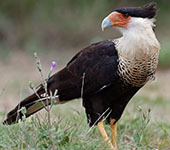 4/3 – Kingston, HRM 92: Ryan MacLean sighted a northern crested-caracara flying northwest over Kingston this afternoon. (Photo of northern crested caracara courtesy of Jeff Parker) 4/3 – Kingston, HRM 92: Ryan MacLean sighted a northern crested-caracara flying northwest over Kingston this afternoon. (Photo of northern crested caracara courtesy of Jeff Parker)
- Mark DeDea
[The northern crested-caracara (Caracara cheriwayis) is related to falcons (Falconidae). The rarity of this sighting is best expressed by both Roger Tory Peterson and David Sibley as they note the species range, in modest populations, from Florida across the Gulf states to Texas, into Mexico, and southward.
The last local crested-caracara sighting was April 26, 2015, in Essex County, six miles south of Ticonderoga. Earlier that month, a crested-caracara was spotted in a farm field in Orange County, the Town of Montgomery, by Curt McDermott. Three months before that in January, Ed McGowan identified a crested-caracara at Bear Mountain State Park. Tom Lake]
Natural History Entries
 3/28 – Washington County, HRM 202: The locally uncommon yellow-headed blackbird, first sighted eight days ago by Zach Schwartz-Weinstein, was found again today near the same spot. (Photo of yellow-headed blackbird courtesy of Scott Varney) 3/28 – Washington County, HRM 202: The locally uncommon yellow-headed blackbird, first sighted eight days ago by Zach Schwartz-Weinstein, was found again today near the same spot. (Photo of yellow-headed blackbird courtesy of Scott Varney)
- Scott Varney (Hudson-Mohawk Bird Club)
3/28 – Greene County, HRM 112: I was out on my second story balcony in West Kill a week ago, soaking up the vernal equinox sunshine, when I heard a chattering behind me. Chimney swifts (Chaetura pelagica) had begun to arrive, and one was bringing bits of straw to the old nest site on the chimney.
- Emily S. Plishner
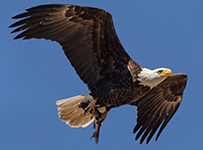 3/28 – Town of Poughkeepsie: It was a day of double fish delivery at bald eagle nest NY62. Each of the adults brought a fish, one a gorgeous goldfish, the other a robust channel catfish. We are still thinking that there is only one nestling, however, albeit one with a voracious appetite. (Photo of bald eagle with channel catfish courtesy of Bob Rightmyer) 3/28 – Town of Poughkeepsie: It was a day of double fish delivery at bald eagle nest NY62. Each of the adults brought a fish, one a gorgeous goldfish, the other a robust channel catfish. We are still thinking that there is only one nestling, however, albeit one with a voracious appetite. (Photo of bald eagle with channel catfish courtesy of Bob Rightmyer)
- Bob Rightmyer
[We like to think of bald eagle nest NY62 as a good representation of other eagle nests in the Hudson River watershed, especially those that we are unable to faithfully monitor. The female in NY62, from three different nests, had now produced a remarkable 22 nestlings across 20 years. Tom Lake]
3/28 – Rockland County, HRM 33: I visited bald eagle nest NY336 today and found the female (best guess) sitting higher in the nest and appeared to be feeding a nestling. At one point, she sat on the rim tearing at a fish and then dropping it down into the nest. I could clearly see her “chewing” the tidbits before placing her head in the nest.
- Chris Galligan
3/28 – Rockland County, HRM 32: After checking on the eagles in NY336, I went to check out another nest, this one at Rockland Lake. It was structurally similar to an eagle nest, but only about one-third the size. But, I thought it was bigger than any hawk nest I had ever seen. The inhabitant was clearly visible with binoculars: a great horned owl. I hear them often in Congers, and have been fortunate enough to see them silhouetted against the sky.
- Chris Galligan
3/29 – Saugerties, HRM 102: We had a harbor seal sighting this afternoon as it followed a tandem kayak to the Saugerties Lighthouse from the northwest cove. This was Day 237 for the harbor seal at Saugerties.
- Patrick Landewe
 3/29 – Ulster County Tributary: Despite a steady drizzle and a brisk running current in this Hudson River tributary, checking our glass eel research fyke net was wonderful. The overnight set had a nice haul of juvenile glass eels, little ribbons of life that connected me instantly to the Sargasso Sea, a thousand miles away in the mid-Atlantic. 3/29 – Ulster County Tributary: Despite a steady drizzle and a brisk running current in this Hudson River tributary, checking our glass eel research fyke net was wonderful. The overnight set had a nice haul of juvenile glass eels, little ribbons of life that connected me instantly to the Sargasso Sea, a thousand miles away in the mid-Atlantic.
Four larger elvers, yearlings, were also in the net; they had survived the gauntlet of their first year in the estuary. Among the eels were several caddisflies, architectural insects with homes of leaves or sticks or tiny stones. On the bright yellow tennis balls that lined the net stakes, new hatches of stone flies gathered. The entire scene was a tableau of survival and beauty and life, even in tough times. The water temperature was 46 degrees Fahrenheit (F) and the air temperature was 50 degrees. (Photo of caddisfly courtesy of Chris Bowser)
- Chris Bowser
[After viewing photos, Bob Schmidt concluded that the caddisflies most probably belonged to the large family Limnephilidae. Tom Lake]
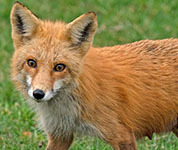 3/29 – Galeville, HRM 74: On a visit to the Shawangunks Grasslands National Wildlife Refuge today, I came literally face-to-face with a gorgeous red fox. (Photo of red fox courtesy of Sheila Bogart) 3/29 – Galeville, HRM 74: On a visit to the Shawangunks Grasslands National Wildlife Refuge today, I came literally face-to-face with a gorgeous red fox. (Photo of red fox courtesy of Sheila Bogart)
- Sheila Bogart
3/29 – Westchester County, HRM 40: Here was another sign of spring: The osprey pair couple had returned to the cell tower on Route 684. Cell tower workers had removed the nest over the winter and now the birds were hard at work rebuilding. This is not their first season, and I hope they have nestlings this season.
- Rick Stafford
3/30 – Fort Edward, HRM 202: I frequently stroll the woods along the Hudson River in Saratoga and Warren counties. Today, I recorded my first close-up encounter with a mink. I was surprised how long the mink posed for me, its fur wet from a trip into the water, before trundling back to dense underbrush.
- Brian Teague
[The American mink (Neovison vison) is a semiaquatic species of mustelid native to North America. They belong to the family Mustelidae, that also includes weasels, otters, and ferrets. The American mink is a carnivore that feeds on rodents, fish, crustaceans, frogs, and birds. Tom Lake]
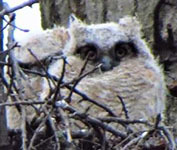 3/30 – Ulster County: Eight days ago, we photographed two tiny great horned owlets in a large twig nest high in a black oak on the edge of a nearby swampland. It was amazing today to see how they had grown, from fluff balls with beaks, in just one week. (Photo of great horned owls courtesy of Mario Meier) 3/30 – Ulster County: Eight days ago, we photographed two tiny great horned owlets in a large twig nest high in a black oak on the edge of a nearby swampland. It was amazing today to see how they had grown, from fluff balls with beaks, in just one week. (Photo of great horned owls courtesy of Mario Meier)
- Mario Meier
 3/30 –Town of Poughkeepsie: What a delight it was today to see one of the adults from bald eagle nest NY372 bring a substantial-sized striped bass to the nest. In all likelihood, this striped bass was a recent arrival from far downriver where it had wintered. (Photo of bald eagle with striped bass courtesy of Bob Rightmyer) 3/30 –Town of Poughkeepsie: What a delight it was today to see one of the adults from bald eagle nest NY372 bring a substantial-sized striped bass to the nest. In all likelihood, this striped bass was a recent arrival from far downriver where it had wintered. (Photo of bald eagle with striped bass courtesy of Bob Rightmyer)
- Bob Rightmyer
3/30 – Kowawese, HRM 59: The wind was whipping over white-caps and the more we tried, despite the optimum low tide, the less we expected to catch fish in our net. The river, at 47 degrees F, was still a bit chilly for seining success. Just down river in shallow Cornwall Bay, an adult bald eagle from one of the local nests was trying its luck hunting for fish, an endeavor they are finely adapted for.
- Tom Lake, Phyllis Lake
3/30 – Hook Mountain, HRM 31: We counted just three migrating raptors today at the Hook Mountain Hawkwatch: one each red-shouldered hawk, Cooper’s hawk, and merlin. Notable non-migratory birds included turkey vulture (13), black vulture (17), red-tailed hawk (2), and one each adult bald eagle and Cooper’s hawk. Perhaps most exciting, a common loon was heard!
- Ajit I. Antony, Liza Antony
[Many of the common loons that use the Hudson Valley as a migratory route spend the winter in the DelMarVa region of Chesapeake Bay. In April they head north, many of them to breeding areas in the Adirondack’s High Peaks. As they move through our area, most of them have moulted into their striking black-and-white breeding plumage. Tom Lake]
3/31 – Kingston, HRM 92: A female eastern phoebe, of the pair that nests on our front porch, arrived today (the male had arrived March 16). As if on cue, a pair of brown-headed cowbirds showed up in the yard. I had not heard or seen any here since last summer. In the past two nesting seasons, the first phoebe clutch was parasitized by the cowbirds, but not the second clutch. I will be curious to see what happens this year.
- Ariane Giudicelli
[Brown-headed cowbirds are well known as “nest parasites.” The female cowbird will lay her eggs in another songbird’s nest, often, but not always of a smaller species. As the eggs hatch, the larger cowbird nestlings tend to have an advantage when feeding time comes, and a better chance of survival. This is an ancient and interesting behavioral adaptation. Tom Lake]
3/31 – Milan, HRM 90: The black bears were back last night. This time it was a sow and her two nearly grown cubs. Despite having little here for them to forage, mom and the cubs did a lot of communicating with grunts and snorts.
- Marty Otter
3/31 – New Paltz, HRM 78: We walked into the sanctuary off Huguenot Street today. Taking our time and watching our footing on mud and wet grassy paths, I looked down to see a tiny painted turtle, no more than an inch-and-a-half long. It was so still until I picked it up and touched its carapace. I can still feel its delicate and tiny clawed feet in my palm before I walked it across the wide path to release it into the water. A thrill and a privilege!
- Ruth Molloy, Betty Boomer
[This was far too early for a 2020 painted turtle hatching, so this was either a yearling that survived the winter, as they are capable of doing, or a release of an unwanted pet. Tom Lake]
3/31 – Newburgh, HRM 63: We could hear nestlings (possibly plural) in bald eagle nest NY488, sounds that began ten days ago. The adults have been regularly bringing fish to the nest, and now there are excited screeches as the fish arrive. As the days go by, the nestlings greet these arrivals with a greater volume. Given the average time for nestling to become fledglings, we may see something during the first week of June.
- Nancy Thomas
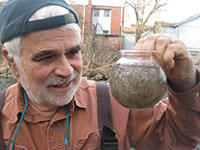 3/31 – Orange County, HRM 60: On this date four years ago (2016), as we hauled our overnight glass eel fyke net from Quassaick Creek, we knew we were in for a long afternoon. Area media had arrived hoping to capture the story in notes and video. We were so impressed by the volume of the catch, and perhaps foolishly eager to follow strict scientific protocol, that we decided to count every last glass eel, a task that took us more than three hours. 3/31 – Orange County, HRM 60: On this date four years ago (2016), as we hauled our overnight glass eel fyke net from Quassaick Creek, we knew we were in for a long afternoon. Area media had arrived hoping to capture the story in notes and video. We were so impressed by the volume of the catch, and perhaps foolishly eager to follow strict scientific protocol, that we decided to count every last glass eel, a task that took us more than three hours.
Counting glass eels requires intense and absolute focus both for accuracy and the safety of the fish (all glass eels are released upstream). After two hours, the media had all left, citing “other duties and responsibilities,” but probably having grown tired of squatting streamside observing our meticulous attention to detail. When the last entry was written in our notebook, the tally was 6,004 glass eels. At the time, this was the second largest one-day catch recorded since we began using fyke nets for glass eels in 2003. (Photo of glass eels courtesy of Tommy Jackson)
- Tom Lake, Hannah Ring
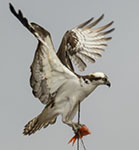 3/31 – Verplanck, HRM 40.5: What a nice surprise to hear the cry of the osprey this morning out on the channel marker off shore from Old Steamboat Dock. Since the male usually arrives first, this one was already out gathering sticks [and a goldfish] to build a new nest (very few osprey nests built on aids-to-navigation structures, such as lights, buoys, and channel markers, survive the winter). We have watched this pair every spring; they work so hard, and it gives us a great sense of relief during these trying times to know that nature is dependable. (Photo of osprey courtesy of Jim Yates) 3/31 – Verplanck, HRM 40.5: What a nice surprise to hear the cry of the osprey this morning out on the channel marker off shore from Old Steamboat Dock. Since the male usually arrives first, this one was already out gathering sticks [and a goldfish] to build a new nest (very few osprey nests built on aids-to-navigation structures, such as lights, buoys, and channel markers, survive the winter). We have watched this pair every spring; they work so hard, and it gives us a great sense of relief during these trying times to know that nature is dependable. (Photo of osprey courtesy of Jim Yates)
- Dianne Picciano
4/1 – Town of Wappinger: I have been taking time each evening to check on bald eagle nest NY459. This evening’s visit seemed to confirm they were still on eggs and they were yet to hatch. One of the adults was in the nest the entire time I watched them, from an appropriate distance, with binoculars.
- Judy Winter
4/1 – Hook Mountain, HRM 31: We counted seven migrating raptors today at the Hook Mountain Hawkwatch, five of which were osprey. The others were, one each, Cooper’s hawk, and bald eagle. Far to the northeast, a peregrine falcon was seen attacking a turkey vulture. Notable non-migratory birds included turkey vulture (9), black vulture (3), and red-tailed hawk (3).
- Ajit I. Antony, Liza Antony
4/2 – Minerva, HRM 284: I checked my maple sap buckets today, and I am thinking that the season is all but over. I have produced three-quarters of a gallon of dark amber and sweet maple syrup (reduced from maple sap). Until next year!
- Mike Corey
4/2 – Waterford, HRM 158: We believe that the female at bald eagle nest NY485 on Peebles Island State Park laid an egg, or eggs, on March 13. More mating followed a few days later and then possibly another egg was laid. If our data is correct, and our calculations accurate, hatching could occur around April 17.
- Howard Stoner, Andrew Prairie
4/2 – Little Stony Point, HRM 55: Steady 30 mile-per-hour north winds, gusting to 35, had the river in a tumult. The wind was furiously pushing the down tide as the raucous river capped over with three-foot-plus white rollers. It was one of those days on the tidewater Hudson when gulls fly backwards. The incredible energy and the ensuing show were out there in the river, because there was no way we were going to get our net in the water.
- Tom Lake, Phyllis Lake
4/2 – Bedford, HRM 35: Things were quiet at the great blue heron rookery. There were eight herons settled down in their nests sitting on eggs. Two herons were standing on the edge of their nests possibly guarding their mates down inside. The incubation period is 27-28-days. In about three weeks we can expect to see signs that eggs have begun to hatch.
- Jim Steck
4/2 – Hook Mountain, HRM 31: We counted fifteen migrating raptors today at the Hook Mountain Hawkwatch. High count was Cooper’s hawk with six. We also spotted a raven diving on a local immature bald eagle and a red-tailed hawk chasing a turkey vulture. Almost all of the migrants were seen coming from south-southeast over Tallman State Park and the flat ridge to the West. Some of them migrated low, dropping below the horizon, making them difficult to follow over the trees. Some became lost over the glittery river. Notable non-migratory birds included adult bald eagle (3), turkey vulture (8), black vulture (4), and red-tailed hawk (4).
- Ajit I. Antony, Liza Antony
4/3 – Minerva, HRM 284: Our pond in the back forty was still socked in with ice. We listened and had no sign of spring peepers [that would come in two days] or red-winged blackbirds.
- Mike Corey
*** Fish of the Week ***
 4/3 – Hudson River Watershed: Fish-of-the-Week for Week 65 is the yellow perch (Perca flavescens) number 163 (of 230) on our watershed list of fishes. If you would like a copy of our list, e-mail - trlake7@aol.com. 4/3 – Hudson River Watershed: Fish-of-the-Week for Week 65 is the yellow perch (Perca flavescens) number 163 (of 230) on our watershed list of fishes. If you would like a copy of our list, e-mail - trlake7@aol.com.
Yellow perch is a freshwater fish, one of eight members of the perch family (Percidae) in our watershed. Four, including the yellow perch, are native. Three others are canal migrants from the Great Lakes. The final species, the nonnative walleye, is a major gamefish that has been widely introduced in the watershed. Yellow perch are native to North America from northwest Canada, through the Midwest to the Canadian Maritimes, and south into the Carolinas. They can trace their ancestry in the watershed back to the end of the Ice Age, at least 15,000 years ago.
Yellow perch may be the most popular recreational fish in the Hudson River watershed with most ranging up to a foot-long. The New York State angling record is 3 pounds 8 ounces from Lake Erie. Presently, there is a harbor seal in the tidewater Esopus Creek at Saugerties that has been regularly foraging on that tributary’s robust yellow perch population. (Photo of yellow perch courtesy of Sandra Avant)
- Tom Lake
4/3 – Ulster County, HRM 86: We are quite confident that the first hatch at bald eagle nest NY142 occurred around March 11, and that the nestlings would now be about three weeks old. We have seen feeding activity but no sign of "little grey bobble-heads" yet. However, NY142 is deep, having often hidden even an adult down inside.
- Dave Lindemann
4/3 – Town of Poughkeepsie: We watched a nice, clean switch-over in late afternoon at bald eagle nest NY62. The female of the pair was flying in from the river, and it did not appear that she was carrying a fish. However, Bob Rightmyer, viewing from another quarter, clearly saw that she was carrying a brown bullhead, not in her talons, but in her mouth. Mom landed, dad took off, the switch over was complete. Within seconds, the female began feeding the catfish to a nestling.
- Tom Lake, Phyllis Lake
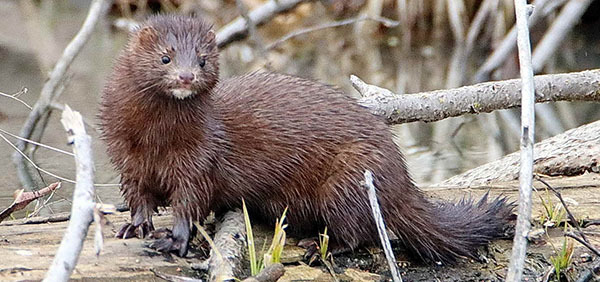
Spring 2020 Natural History Programs
DEC advises New Yorkers to take measures to reduce bear conflicts
State Department of Environmental Conservation (DEC) Commissioner Basil Seggos reminds New Yorkers to take steps to reduce conflicts with bears. Feeding bears either intentionally, which is illegal, or unintentionally through careless practices around properties, has consequences for entire communities. DEC advises everyone who lives in or visits bear habitat, which is much of Upstate New York, to remove items that are attractive to bears. People should take down bird feeders by April 1, store garbage inside secure buildings, and feed pets indoors. These actions are necessary to live responsibly with black bears, protect people, property, and bears.
For more information about how to reduce human/bear conflicts, visit DEC's website.
Guidelines on how to avoid problems with black bears: http://www.dec.ny.gov/press/113258.html
DEC Announces Changes to 2020 Striped Bass Fishing Regulations
State Adopts New Recreational and Commercial Slot Size Limits
The New York State Department of Environmental Conservation (DEC) has adopted new regulations for recreational and commercial fishing for Atlantic striped bass. These regulations, which take effect immediately, are to reduce state commercial and recreational harvests by 18 percent as required by the Atlantic States Marine Fisheries Commission (ASMFC). Recreational striped bass seasons start on April 1 in the Hudson River and tributaries and on April 15 in marine waters. Anglers are encouraged to use circle hooks in 2020 when using bait.
For more information on fishing, visit DEC’s website: https://www.dec.ny.gov/outdoor/fishing.html
DEC reminds anglers to practice social distancing to prevent the potential spread of COVID-19.
2020 Striped Bass Recreational Regulations:
In marine waters:
• Slot size limit: 28" - 35" total length
(No fish smaller than 28" or greater than 35" may be kept)
• Season date: April 15 - December 15
• Daily possession limit of 1 fish/angler
In the Hudson River and its tributaries:
• Slot size limit: 18"- 28" total length
(No fish smaller than 18" or greater than 28" may be kept)
• Season date: April 1 - November 30
• Daily possession limit of 1 fish/angler
DEC Seeks Birdwatchers to contribute to 2020 Breeding Bird Atlas
State Department of Environmental Conservation (DEC) Commissioner Basil Seggos has announced a call for citizen-science volunteers to help in the development of a comprehensive, statewide survey that takes place every two decades to detail New York’s breeding bird distribution. Starting in 2020, five years of field surveys will be conducted by volunteers and project partners to provide the data that will be analyzed to create the third New York State Breeding Bird Atlas.
“Just as New Yorkers are embarking on the 2020 Census to track human populations and trends, DEC and our partners track our natural populations to evaluate the effectiveness of New York’s programs and initiatives to promote diverse and healthy wildlife,” Commissioner Seggos said. “The Breeding Bird Atlas is a valuable tool to help protect birds and habitat, and I encourage all New Yorkers to get outdoors safely and responsibly and participate in this year’s survey while practicing social distancing.”
DEC is partnering with the New York Natural Heritage Program, SUNY College of Environmental Science and Forestry (ESF), Audubon New York, Cornell Lab of Ornithology, New York State Ornithological Association, and New York Cooperative Fish and Wildlife Research Unit on this project. When complete, the atlas will provide species-specific details about distribution, maps, and illustrations.
The last atlas was published in 2008, with information on its results available on DEC’s website. Five years of fieldwork by more than 1,200 contributors provided the data for the second addition to New York’s understanding of the state’s avifauna (birds). This substantial book revealed striking changes in the distributions of many of our breeding birds since New York's first Breeding Bird Atlas was published in 1988. Data showed that half of New York’s 253 species showed a significant change in their distribution, with 70 species showing increases and 58 species showing declines. A comparison study between the first two atlases showed that the distribution of 129 species moved northward an average of 3.58 kilometers due to climate change. The 2020 atlas will provide further data on this shift and climate change’s potential impact on wildlife.
To participate, volunteers can make a free eBird account and submit data online through the atlas website (ebird.org/atlasny) or via the eBird mobile app. Simply record the species and any breeding behaviors observed. All sightings can count. As observations are reported, data can be viewed here: https://ebird.org/atlasny/state/US-NY.
Hudson River Miles
The Hudson is measured north from Hudson River Mile 0 at the Battery at the southern tip of Manhattan. The George Washington Bridge is at HRM 12, the Tappan Zee 28, Bear Mountain 47, Beacon-Newburgh 62, Mid-Hudson 75, Kingston-Rhinecliff 95, Rip Van Winkle 114, and the Federal Dam at Troy, the head of tidewater, at 153. The tidal section of the Hudson constitutes a bit less than half the total distance – 315 miles – from Lake Tear of the Clouds to the Battery. Entries from points east and west in the watershed reference the corresponding river mile on the mainstem.
To Contribute Your Observations or to Subscribe
The Hudson River Almanac is compiled and edited by Tom Lake and emailed weekly by DEC's Hudson River Estuary Program. Share your observations by e-mailing them to trlake7@aol.com.
To subscribe to the Almanac (or to unsubscribe), use the links on DEC's Hudson River Almanac or DEC Delivers web pages.
Discover New York State
The Conservationist, the award-winning, advertisement-free magazine focusing on New York State's great outdoors and natural resources. The Conservationist features stunning photography, informative articles and around-the-state coverage. Visit The Conservationist webpage for more information.
Useful Links
National Oceanic and Atmospheric Administration online tide and tidal current predictions are invaluable when planning Hudson River field trips.
For real-time information on Hudson River tides, weather and water conditions from sixteen monitoring stations, visit the Hudson River Environmental Conditions Observing System website.
DEC's Smartphone app for iPhone and Android is now available at: New York Fishing, Hunting & Wildlife App.
NY's Outdoors Are Open
#RecreateLocal-- Safely and Responsibly
DEC and Office of Parks, Recreation and Historic Preservation (State Parks) are encouraging New Yorkers to engage in responsible recreation during the ongoing COVID-19 public health crisis. DEC and State Parks recommendations incorporate guidance from the Centers for Disease Control and Prevention and the New York State Department of Health for reducing the spread of infectious diseases and encourage New Yorkers to recreate locally, practice physical distancing, and use common sense to protect themselves and others. In addition, DEC and State Parks launched a new hashtag-#RecreateLocal-and encourage New Yorkers to get outside and discover open spaces and parks close to home.
Information about the Hudson River Estuary Program is available on DEC's website at http://www.dec.ny.gov/lands/4920.html.
|


 4/3 – Kingston, HRM 92: Ryan MacLean sighted a northern crested-caracara flying northwest over Kingston this afternoon. (Photo of northern crested caracara courtesy of Jeff Parker)
4/3 – Kingston, HRM 92: Ryan MacLean sighted a northern crested-caracara flying northwest over Kingston this afternoon. (Photo of northern crested caracara courtesy of Jeff Parker) 3/28 – Washington County, HRM 202: The locally uncommon yellow-headed blackbird, first sighted eight days ago by Zach Schwartz-Weinstein, was found again today near the same spot. (Photo of yellow-headed blackbird courtesy of Scott Varney)
3/28 – Washington County, HRM 202: The locally uncommon yellow-headed blackbird, first sighted eight days ago by Zach Schwartz-Weinstein, was found again today near the same spot. (Photo of yellow-headed blackbird courtesy of Scott Varney) 3/28 – Town of Poughkeepsie: It was a day of double fish delivery at bald eagle nest NY62. Each of the adults brought a fish, one a gorgeous goldfish, the other a robust channel catfish. We are still thinking that there is only one nestling, however, albeit one with a voracious appetite. (Photo of bald eagle with channel catfish courtesy of Bob Rightmyer)
3/28 – Town of Poughkeepsie: It was a day of double fish delivery at bald eagle nest NY62. Each of the adults brought a fish, one a gorgeous goldfish, the other a robust channel catfish. We are still thinking that there is only one nestling, however, albeit one with a voracious appetite. (Photo of bald eagle with channel catfish courtesy of Bob Rightmyer) 3/29 – Ulster County Tributary: Despite a steady drizzle and a brisk running current in this Hudson River tributary, checking our glass eel research fyke net was wonderful. The overnight set had a nice haul of juvenile glass eels, little ribbons of life that connected me instantly to the Sargasso Sea, a thousand miles away in the mid-Atlantic.
3/29 – Ulster County Tributary: Despite a steady drizzle and a brisk running current in this Hudson River tributary, checking our glass eel research fyke net was wonderful. The overnight set had a nice haul of juvenile glass eels, little ribbons of life that connected me instantly to the Sargasso Sea, a thousand miles away in the mid-Atlantic. 3/29 – Galeville, HRM 74: On a visit to the Shawangunks Grasslands National Wildlife Refuge today, I came literally face-to-face with a gorgeous red fox. (Photo of red fox courtesy of Sheila Bogart)
3/29 – Galeville, HRM 74: On a visit to the Shawangunks Grasslands National Wildlife Refuge today, I came literally face-to-face with a gorgeous red fox. (Photo of red fox courtesy of Sheila Bogart) 3/30 – Ulster County: Eight days ago, we photographed two tiny great horned owlets in a large twig nest high in a black oak on the edge of a nearby swampland. It was amazing today to see how they had grown, from fluff balls with beaks, in just one week. (Photo of great horned owls courtesy of Mario Meier)
3/30 – Ulster County: Eight days ago, we photographed two tiny great horned owlets in a large twig nest high in a black oak on the edge of a nearby swampland. It was amazing today to see how they had grown, from fluff balls with beaks, in just one week. (Photo of great horned owls courtesy of Mario Meier) 3/30 –Town of Poughkeepsie: What a delight it was today to see one of the adults from bald eagle nest NY372 bring a substantial-sized striped bass to the nest. In all likelihood, this striped bass was a recent arrival from far downriver where it had wintered. (Photo of bald eagle with striped bass courtesy of Bob Rightmyer)
3/30 –Town of Poughkeepsie: What a delight it was today to see one of the adults from bald eagle nest NY372 bring a substantial-sized striped bass to the nest. In all likelihood, this striped bass was a recent arrival from far downriver where it had wintered. (Photo of bald eagle with striped bass courtesy of Bob Rightmyer) 3/31 – Orange County, HRM 60: On this date four years ago (2016), as we hauled our overnight glass eel fyke net from Quassaick Creek, we knew we were in for a long afternoon. Area media had arrived hoping to capture the story in notes and video. We were so impressed by the volume of the catch, and perhaps foolishly eager to follow strict scientific protocol, that we decided to count every last glass eel, a task that took us more than three hours.
3/31 – Orange County, HRM 60: On this date four years ago (2016), as we hauled our overnight glass eel fyke net from Quassaick Creek, we knew we were in for a long afternoon. Area media had arrived hoping to capture the story in notes and video. We were so impressed by the volume of the catch, and perhaps foolishly eager to follow strict scientific protocol, that we decided to count every last glass eel, a task that took us more than three hours. 3/31 – Verplanck, HRM 40.5: What a nice surprise to hear the cry of the osprey this morning out on the channel marker off shore from Old Steamboat Dock. Since the male usually arrives first, this one was already out gathering sticks [and a goldfish] to build a new nest (very few osprey nests built on aids-to-navigation structures, such as lights, buoys, and channel markers, survive the winter). We have watched this pair every spring; they work so hard, and it gives us a great sense of relief during these trying times to know that nature is dependable. (Photo of osprey courtesy of Jim Yates)
3/31 – Verplanck, HRM 40.5: What a nice surprise to hear the cry of the osprey this morning out on the channel marker off shore from Old Steamboat Dock. Since the male usually arrives first, this one was already out gathering sticks [and a goldfish] to build a new nest (very few osprey nests built on aids-to-navigation structures, such as lights, buoys, and channel markers, survive the winter). We have watched this pair every spring; they work so hard, and it gives us a great sense of relief during these trying times to know that nature is dependable. (Photo of osprey courtesy of Jim Yates) 4/3 – Hudson River Watershed: Fish-of-the-Week for Week 65 is the yellow perch (Perca flavescens) number 163 (of 230) on our watershed list of fishes. If you would like a copy of our list, e-mail -
4/3 – Hudson River Watershed: Fish-of-the-Week for Week 65 is the yellow perch (Perca flavescens) number 163 (of 230) on our watershed list of fishes. If you would like a copy of our list, e-mail - 